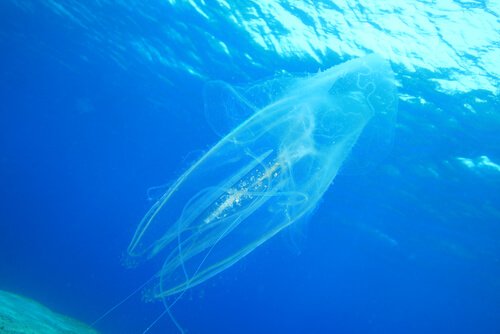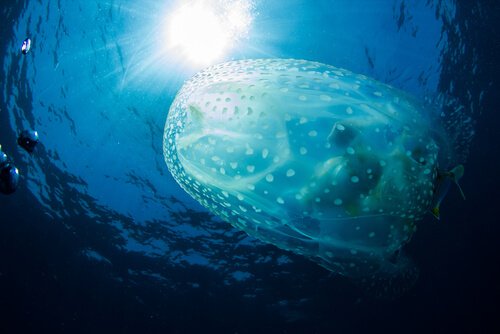Sea Wasp: Characteristics and Habitat

The sea wasp, also known as Chironex fleckeri or box jellyfish, lives in Australian and the south-eastern Asian waters. There are almost 200 known species of jellyfish swimming in our planet’s seas.
While many jellyfish are actually harmless, scientists think that the sea wasp is the most poisonous marine animal discovered so far. Its venom is so powerful that those who have been stung by it say that they went through such excruciating pain that it shocked and stunned them, even before it took full effect.
In addition to its venom, the box jellyfish is almost invisible, making it difficult to detect. Furthermore, it is active during the day and prefers to hunt in shallow water. That increases the chances of it coming into contact with unsuspecting swimmers.
Physical description
The name given to them in Australia, the box jellyfish, comes from the boxy shape of their bells. Their bodies are semi-transparent and tend to measure between 6 and 9 inches. However, their body diameter can be up to approximately 14 inches.
Their tentacles hang from each corner, and each side can hold up to 15 tentacles, each about 10 feet long. The sea wasp is pale blue, and very difficult to see, even in clear ocean waters. For years, this trait has prevented us from knowing what was causing us such terrible pain, often followed by death.

Each tentacle contains millions of nematocysts, microscopic hooks in which venom is stored and distributed. Sea wasps contain sensory organs that include 24 eyes, but they don’t have brains.
Reproductive habits
Each spring, sea wasps gather to spawn in rivers or other similar bodies of water. They find a mate in freshwater, and there they release eggs or sperm, depending on their sex, directly into the water. Once fertilization occurs, the planula (larva) adheres to a hard surface and becomes a small polyp.
The polyps are tiny. They measure from 1 to 2 millimeters long and look like a live ball with two tentacles. They use those tentacles to adhere to stones or other surfaces where they won’t be exposed, like a crack in the rocks, or underneath the rocks.
Once the polyp has finished sprouting, it becomes a juvenile jellyfish. The juvenile grows until sexually mature, and travels from the river to the sea. There, the jellyfish continue to grow until they reach full size: from 6 to 9 inches in length.

A mature sea wasp dies shortly after releasing sperm, and doesn’t intervene in the upbringing of its offspring. Because of this, scientists believe that box jellyfish live for just under a year.
Behavior of the sea wasp
Box jellyfish have several behavioral traits that distinguish them from other jellyfish. In particular, sea wasps can swim actively, while most other species float, and are carried away by the current.
Another difference is that sea wasps rest at the bottom of the sea and don’t move unless someone disturbs them. Scientists believe that this rest phase helps them compensate for the energy they use while swimming actively. They usually swim more slowly during the day, which is probably because they hunt or consume their prey.
During very active swell seasons, they descend into deep water until the sea calms down. Stings to humans happen involuntarily, and can be fatal. Scientists estimate that its main victims are children and young adults.
Habitat of the sea wasp
It lives mainly in the waters of the Australian continent and southeast Asia. It inhabits parts of the Indian Ocean, Pacific Ocean, and the Great Barrier Reef. Sea wasps also inhabit the waters off the western coast of Australia.
Human stings have occurred mostly in the oceanic waters of Queensland, on Australia’s east coast. Scientists believe that the sea wasp may also be responsible for stings reported near the Philippines.
All cited sources were thoroughly reviewed by our team to ensure their quality, reliability, currency, and validity. The bibliography of this article was considered reliable and of academic or scientific accuracy.
https://www.nationalgeographic.es/animales/avispa-del-mar
This text is provided for informational purposes only and does not replace consultation with a professional. If in doubt, consult your specialist.